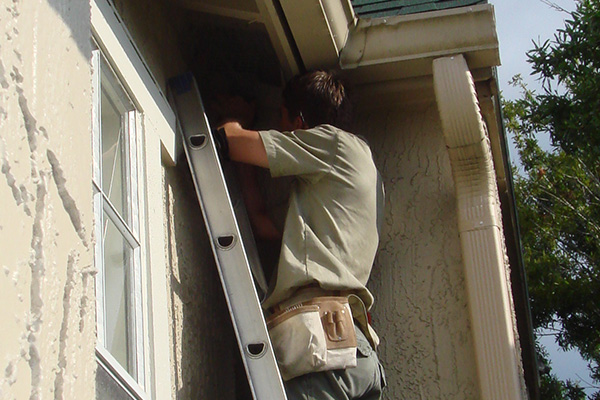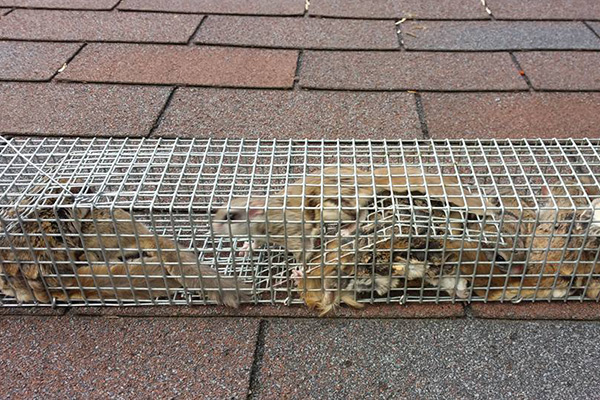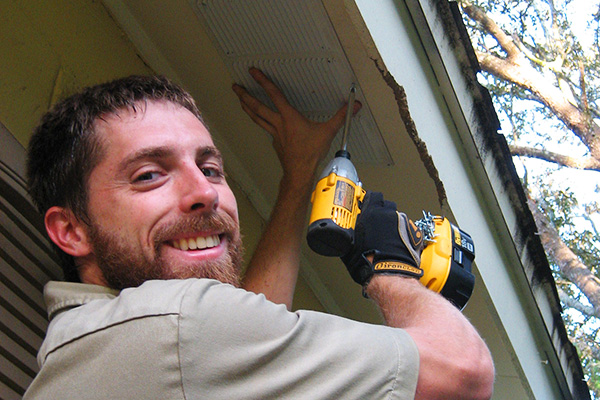- info@animalatticpest.com
- Call - we service 300 locations

How To Get Flying Squirrels Out of Your Attic
Flying squirrels are nocturnal, and they live in colonies. That means that you most likely hear the noise of flying squirrels at night, and you might hear the pitter-patter of several little feet. You might
also hear them rolling nuts around. Flying squirrels are small, and thus they can enter the house through very small gaps or holes. They can also climb anything, and glide most anywhere, so the entry hole might
be anywhere on your house, but it's most likely on the roof somewhere, or the eaves, or a gable vent, or something like that.
Flying squirrel removal is challenging. They are trickier than gray squirrels, because the entry hole is smaller, and they live in larger groups. However, the process for removal from the attic is the same as it
is for other animals, like the Eastern Gray Squirrel. First, you've got to inspect the attic to make sure of what animal you are dealing with, then you've got to inspect the exterior of the home to find out how they
are getting in. If you don't find the entry hole(s), you have no chance of solving the problem. Making sure all secondary points of entry are sealed shut with steel screen, mount either a one-way door or a repeater
trap (pictured below) over the main hole, and you'll be able to remove the whole colony in one shot! After you are sure they are all out of your attic, remove the trap and seal that last hole. Finally, you can
clean the attic of the flying squirrel waste, and check for damage, such as chewed wires as well. If you need professional help, we service most of the United States:
click here to hire us in your town.
How to Get Rid of Flying Squirrels in the Attic - 4 How-To Steps
1 - Inspect the Attic for Flying Squirrels
Inspect inside your attic for flying squirrel sign. Look for the animal(s), or their feces, or tracks, or damage so that you know what kind of critter you are dealing with.
2 - Inspect the Exterior of the Home
If you've got flying squirrels in the attic, they are getting inside somehow. You have open holes or gaps leading inside the house! You must find these areas to solve the problem.
3 - Remove or Trap the Flying Squirrels
The best way to get rid of flying squirrel in the attic is to set a one-way exclusion door or repeater trap, like the one pictured above. That gets the whole colony at once!
Information About Flying Squirrels in the Attic
How To Get Flying Squirrels Out Of Your Attic
Like all other wildlife that can get into your attic, flying squirrels can cause all sorts of issues. In addition to making noise when they scurry around your attic at night, they can chew on wood inside and outside of your home as well as wires in the attic. In the case of larger colonies, they can also cause a strong odor and in any case, they will leave you a mess to clean up once they are gone. To minimize these issues, you want to get flying squirrels out of your attic as soon as possible. To accomplish this goal, follow these steps.
Confirm It Is Flying Squirrels
The very first thing you will need to do is make sure that it truly is flying squirrels in your attic and not another animal, such as regular squirrels. If you don’t actually see one of the squirrels on a trip into your attic, you still confirm that it is these animals based on their scent, tracks, or droppings. Click here for Flying Squirrel Feces Photos of Poop.
You may need to do a bit of research or consult a professional to confirm the animal in question is a flying squirrel without actually seeing them.
Find Entry Points
Once you know that you are dealing with flying squirrels, it is time to figure out how they got into your attic. These animals prefer to enter the attic by the roof or somewhere else high up so focus your inspection on this area although you should look everywhere. Like regular squirrels, flying squirrels can fit in very small spaces so any hole should be considered a possibility. Remember that there may be more than one entry point for the squirrels.
Use Exclusion
The simplest method of getting flying squirrels out of your attic is to use exclusion. To do this, you would start by sealing up all of the entry points you identified except one. Make sure that this entrance is regularly used by the squirrels and is hopefully the main one. Place a one-way door or another type of exclusion device over the hole. The flying squirrels will be able to leave but not get back inside. Over the course of a few days, they will leave in search of food and remain outside with no way to get back in. Once you can confirm that all the flying squirrels are out of your attic, you can take the exclusion device off the entry point and immediately seal it up. Unless all entrances are sealed, more squirrels will just come inside.
Set Traps And Relocate
The other option for flying squirrels is trapping and relocating them. Before doing this, make sure that it is legal in your area. Some parts of the country require special licenses to trap and/or relocate certain wildlife, including flying squirrels and you don’t want to be fined for not getting one. Once you are sure you are legally ready to trap and relocate the flying squirrels you can get started.
You can set a repeating live cage trap inside the attic, but you will get the best results by putting a repeating trap on the squirrel’s exit hole, in the same spot you would have put the exclusion device. Keep an eye on the trap so no squirrels are left inside of it for too long as they can become dehydrated or get injured from exhaustion. Now, you can take the squirrels to the area you plan on releasing them. Be sure that you choose a woodland area that isn’t by domestic properties so the squirrels will be safe from people and have shelter from predators along with food. In some cases, you may be legally required to bring the flying squirrels to a certain area. Always pick a location that is at least five miles from your home so they don’t return.
If you are placing the repeating trap inside the attic, then you will want to pre-bait it. This involves placing bait on it without setting the trap for several days as a way to get the flying squirrels used to it. You can use a range of bait options, such as peanut butter, sunflower seeds, grains, fruit, and apples.
Or Hire A Professional
The entire process of getting flying squirrels out of your attic will go much more smoothly if you hire a professional to take care of it for you. They will be able to quickly identify whether this is actually the animal you have. They will also know where to look for entry holes and already have the necessary traps or exclusion devices on hand.
Clean Your Attic
Whether you get the flying squirrels out of your attic yourself or hire a professional, you will need to thoroughly clean the space afterwards. Wear protective gloves and a face mask while doing so and remove all waste products before decontaminating the area with a disinfectant.
The Bottom Line
How to get rid of flying squirrels in the attic - they are not so easily just "gotten rid of". But they can be properly and effectively removed, and the problem can be prevented from happening again. Remember to follow the steps above, whether you do it yourself or hire a professional to do it for you. It is not easy work, but if you don't remove the flying squirrels in your attic, they will go on to cause further damage. When you do decide to remove them, please remember to treat the animals with respect, and take the work seriously, and remember about the presence of baby flying squirrels in the attic. You can get rid of flying squirrels in the attic if you follow the correct approach. Best of luck!




